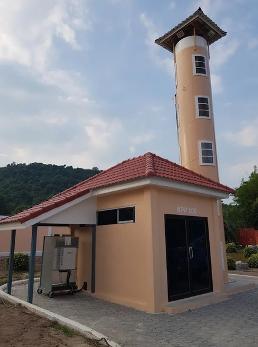Entirely novel and environmentally friendly energy technologies
Self-running and zero emission power plants from the company Rosch
Last update 5 April 2025
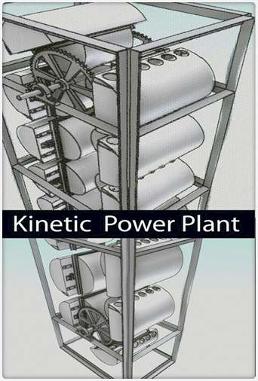
Sketch of the buoyancy part of a kinetic power plant (KPP). It comprises a water column which contains a chain drive, fillable containers which are attached at the chain drive, and a valve system which can fill the containers with air. Image from Ref. 1. Not shown in this picture are other parts of the KPP like an electric generator, an electrically-operated compressor, and a control unit.
Picture from the 100 kW demo plant in Thailand. Image copied via screenshot on 6 June 2022 from the Ki-TECH website https://www.ki-tech.global/home-loginl which comprises also other pictures
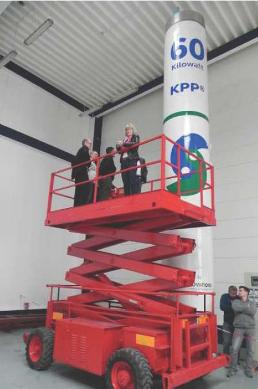
Picture from a former 60 kW pilot plant. Image from Ref. 7 g
Abstract / Summary: The company Rosch Innovations / Save The Planet AG has developed so-called kinetic power plants (KPPs). These self-running and zero emission power plants generate permanently usable electric energy without any fuels, wind power or solar energy. Rosch offers via distribution partners industrial size power plants with an electric output power of 5, 40, and 100 MW as well as 1 MW and from 5 MW with fully scalable 500 kW modules . Distribution partners are e.g. the global engineering, procurment, and construction company Ki-TECH for the KPP technology and the German company E-Cat Deutschland GmbH . An industrial size power plant at a publicly known and visitable customer site does not yet exist. However, potential industrial customers or potential licensees can visit and inspect an operating 100 kW and 500 kW power plant, on condition that they have provided a letter of intent and a proof of funds. The 100 kW and 500 kW power plants are located at a Rosch site in Thailand where they power that site and feed electricity into the grid, see the following video from 2022: https://www.youtube.com/watch?v=3IdNow8vZdg
. An inspection by an engineer team of the potential customer or potential licensee allows a verification of the genuineness of the power plants and rule out possible objections such as a hidden power source. See, for example, the results of a technical examination of the 100 kW power plant in Thailand from 2018: http://borderlands.de/Links/KPP-Messung061218-Wunder+Holper.pdf . As already mentioned, an industrial size power plant at a publicly known and visitable
customer site does not yet exist. However, globally there are some power plants under construction [7r] and there are some large projects which are in the planning stage, see e.g. the website https://wvge-me.com which presents projects and a roadmap for Montenegro and other Balkan states. There is meanwhile also a beneficial situation for potential KPP customers / purchasers, namely the CEO from the company Ki-TECH can provide for them a 100 percent bank guarantee. Pictures on the left: Sketch of the buoyancy part of a kinetic power plant, the 100 kW demo plant in Thailand, and a former 60 kW pilot plant. An often
asked question is from where the generated energy comes from. The author
of this report and website assumes that this novel energy technology is
just one type of many possible types of systems which extract usable
energy from an hitherto untapped and everywhere available energy form
and source which is called space energy, vacuum energy, or ether energy
[8]. Papers about such an advanced and little-known approach are also
published in established science journals, see e.g. Refs. [11-14] and in papers which are presented on the home page
The company Rosch Innovations / Save The Planet AG has developed so-called kinetic or buoyancy power plants which are self-running, i.e.they generate permanently usable electric energy without any fuels, wind power or solar energy. These zero-emission power plants consist of a control unit, an electric generator, an electrically-operated compressor which produces compressed air, a water column which contains a chain drive, fillable containers which are attached at the chain drive, and a valve system which can fill the containers with air.
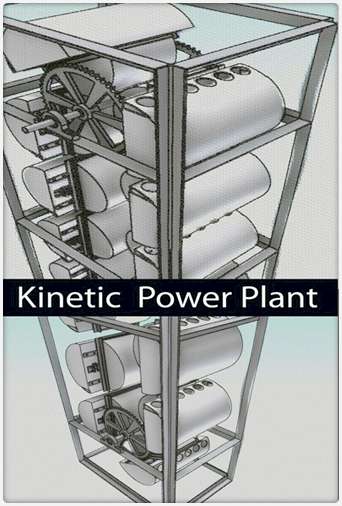
A pilot plant was developed and is located at the research and development (R&D) laboratory of Rosch in Belgrade in Serbia. Several scientists who are working at the Rosch R&D lab have previously worked in military research projects. The pilot plant at the Rosch R&D lab requires an electric input power of 1,6 kW and generates an electric output power of 11,8 kW.
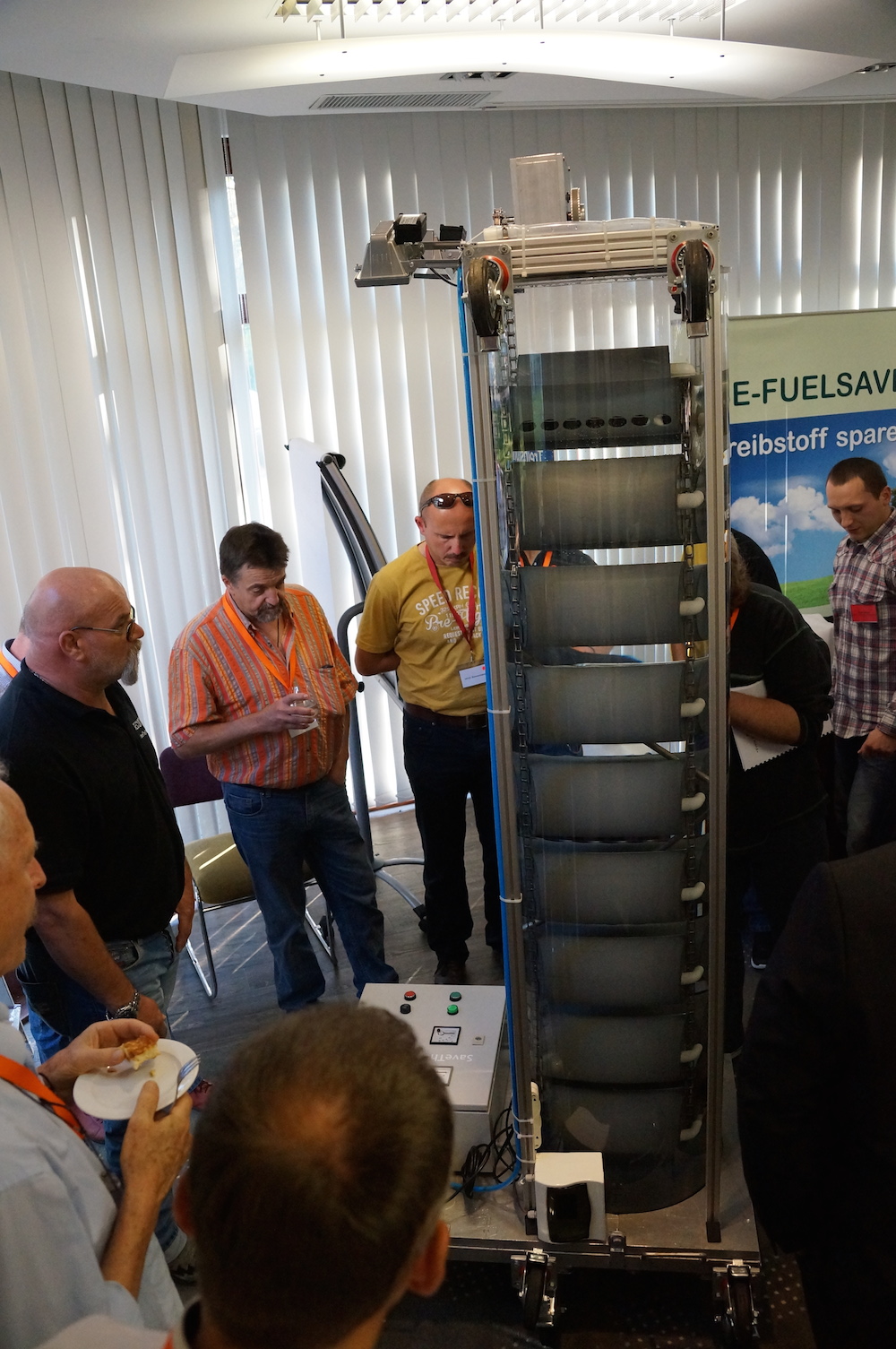
A self-running demonstration model with approximate dimensions 60 × 60 × 230 cm was presented at a congress about entirely novel energy technologies in Bregenz in Austria on 18 October 2014 [5]. The casing for the water column and the chain drive is made of acrylic glass. After a short initial supply of electric power from a battery the demonstration model started its self-running operation. The electric generator produced electricity not only for electrical loads but also for the electrically-operated system components such as the compressor and control unit. The demonstration model did generate an electric power of a few hundred watts for about two hours. The author of this report and website has viewed the self-running demonstration model at the congress in Bregenz. After about two hours operation the demonstration model was switched off and prepared for removal.
In April and May 2015 Rosch and the Austrian Association GAIA have presented a self-runniing and zero emission 5 kW pilot plant at a Rosch site nearby Cologne in Germany. Public viewing dates were available in the period from 25 April 2015 to 6 May 2015, Another public viewing event took place on 13 May 2015. On that day the 5 kW pilot plant was switched off and disassembled. A video from the disassembling is available in Ref. [6]. The author of this report and website has attended two events at the Rosch site nearby Cologne in Germany, namely on 1 and 13 May 2015. During these both visits the author of this report and website has seen that the
Rosch site nearby Cologne in Germany comprises a reception, offices and large
halls for the manufacture of prototypes and demonstration models.
The 5 kW pilot plant consisted of a steel tube, an electrically operated compressor, an electrical generator and a control unit. The steel tube contained the chain drive, fillable containers which were attached at the chain drive, a valve system which can fill the containers with air, and water. The height and diameter of the steel tube was about 4,3 m and about 45 cm, respectively. Located at the top of the steel tube was the compressor, a gear and the generator which generated three-phase electric power with a voltage of about 400 V. The weight of the complete system without water was about 300 kg. The steel tube was fixed at the ground and laterally at the wall. This fixation prevents an overturning of the heavy steel tube in case of a malfunction of the chain drive. The total height of the overall system was about 5 m including space for a lifting device for maintenance. The generator produced electricity also for the compressor and the control unit and the usable electric output power was 4,8 kW. Several powerful lamps and infrared heaters served as electrical loads with a total power of 4,8 kW.
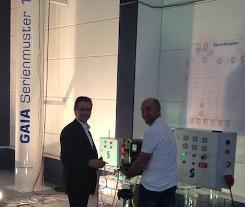
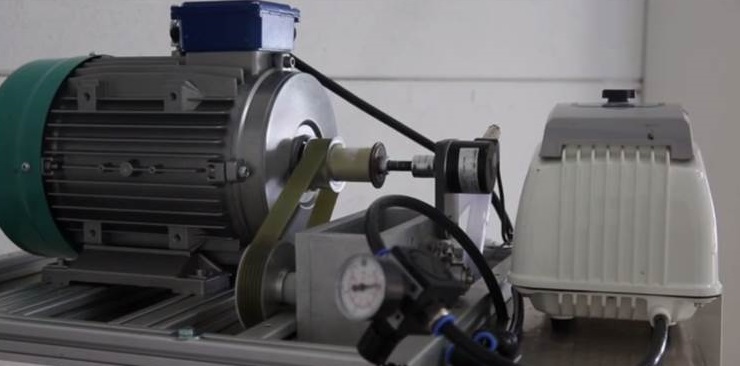
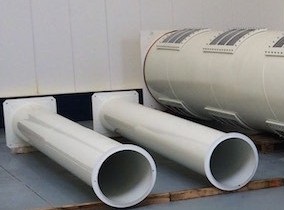
It was intended by GAIA and Rosch to
make the 5 kW power plant commercially available. However, their collaboration did not work well and finally Rosch and GAIA have
abandoned their cooperation.
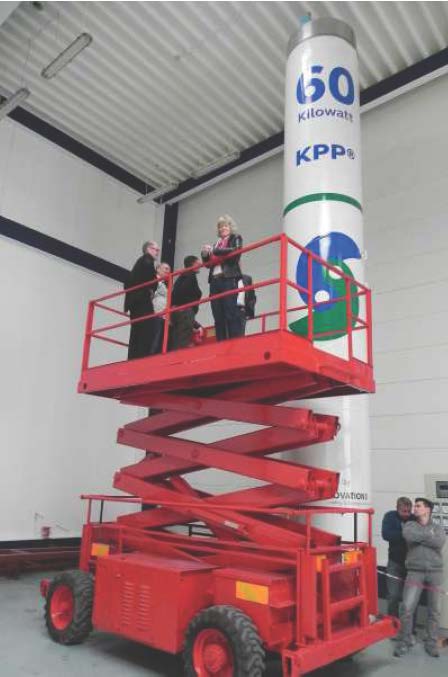
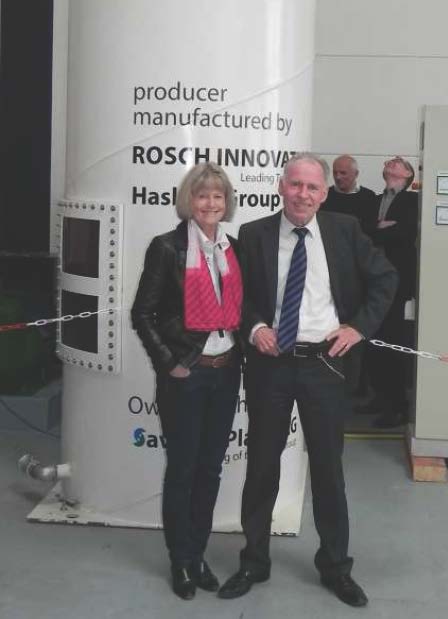
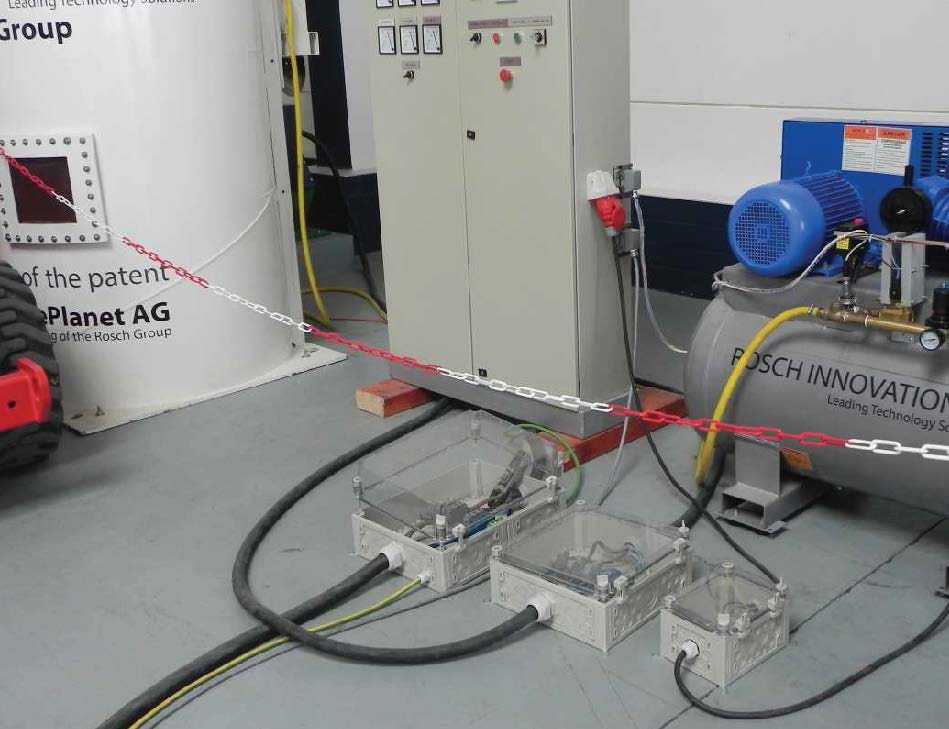
The company Rosch Innovations / Save The Planet AG offers via distribution partners industrial size power plants with an electric output power of 5, 40, and 100 MW as well as 1 MW and from 5 MW with fully scalable 500 kW modules . Distribution partners are e.g. the global engineering, procurment, and construction company Ki-TECH for the KPP technology and the German company E-Cat Deutschland GmbH . Potential industrial customers or potential licensees can visit a Rosch site in Thailand where an operating 100 kW and 500 kW power plant can be viewed and inspected. The distribution partner or Rosch will request from a potential industrial customer or potential licensee a letter of intent and a proof of funds before arranging a visit at the Rosch site in Thailand. That is just a measure to ensure that a potential customer or potential licensee has serious intentions.
Three pictures of a former 60 kW pilot plant are presented on the left [7g]. The diameter of the steel tube is 1,3 m. This former 60 kW pilot plant was several years available at a Rosch site in Germany. Meanwhile, however, it is relocated to an undisclosed location.
There are several potential customers for the industrial size kinetic power plants. For various reasons an industrial size power plant at a publicly known and visitable customer site does not yet exist. Examples of such reasons were / are
- Some potential customers want to get a feed-in compensation when their power plant feeds electricity into the grid. So far the responsible public authorities have not approved a feed-in compensation for the power plants from Rosch
- Some potential customers wanted first to see and inspect a working 500 kW pilot plant which was previously still under construction. This was indeed an important item because a power plant of the size 5 - 100 MW consists of many 500 kW units. However, meanwhile, as mentioned above, an operating 500 kW power plant is available
- The granting of a credit by a bank is finally not approved because there is so far no power plant from Rosch at a publicly known and visitable site of a customer
- Still ongoing negotiations between Rosch and potential licensees
- A customer who operates already a power plant does not want to publicize his or her name and location
Meanwhile, however, there is a beneficial situation for potential customers / purchasers, namely the CEO from the company Ki-TECH can provide for them a 100 percent bank guarantee.
The following did also happen. A potential customer has inspected a pilot plant and did not detect any indications for a hidden external power supply. Nevertheless, he / she decided not to purchase such a power plant because she / he still believes that a self-running device which provides usable energy and power cannot exist. This illustrates that deeply rooted paradigms, assumptions and beliefs can be still cherished even if it is proved that their validity is not universal.
Another reasons why it
takes so long to make entirely novel and environmentally friendly
energy technologies tangible are presented here as well as in a correspondingly labeled
section in this information document .
An often discussed issue is the question if the Rosch power plants are really genuine or just a deception. The viewpoint of the author of this report and website is the following. Actually, there were / are several items which give rise to critical questions and comments:
The self-running and zero emission demonstration model which was shown on 18 October 2014 in Bregenz in Austria was switched off after about 2 hours and then prepared for removal. One could raise the question if the system did really run autonomously. Perhaps it did run for 2 hours by batteries which were placed in the control cabinet. The author of this report and website did ask the Rosch staff member who prepared the demonstration model for removal why it was switched off and prepared for removal after about 2 hours. His answer was "It is home time". On the one hand that is understandable because he transported the demonstration model to the conference location, put it into operation, supervised it, prepared it for removal, and transported it back to the company Rosch. On the other hand a switching off after about 2 hours appears inappropriate because a longer operating time such as 24 hours is required to convince the conference participants or other people that this entirely novel technology is unambiguously genuine and not a deception. An extended operating time would have been possible if the correspondingly extended working time had been spread over several staff members.
Is it absolutely certain that the 5 kW Rosch / GAIA pilot plant did run autonomously ? Maybe it was somehow provided with electric power.
It would have been better if the 5 kW Rosch / GAIA pilot plant were not installed and inspected at a Rosch site but at an external non-Rosch location.
After the disassembly of the 5 kW Rosch / GAIA pilot plant on 13 May 2015 the course and communication of the 5 kW power plant project did appear unsatisfying and it is desirable to make the 5 kW power plant again available.
At the beginning of the cooperation between Rosch and GAIA, Rosch was willing to make the 5 kW power plants commercially available. After the termination of the cooperation between Rosch and GAIA it would have been possible that Rosch alone offers the 5 kW power plant. The author of this report and website was told that Rosch does not want that because the knowledge concerning the electromagnetic generators of the 5 kW power plants is not appropriately protected (by a patent and / or otherwise). However, why was Rosch then willing to support the availability of the 5 kW power plants at the beginning of the cooperation between Rosch and GAIA ? It should be noted that small kinetic power plants such as the 5 kW type are less economic than large kinetic power plants such as the 1 MW type. Therefore Rosch favors in general the large industrial size power plants.
Rosch offers industrial size power plants with an electric output power of 200 kW - 100 MW. The 200 kW power plant comprises three 100 kW units and a working 100 kW pilot plant already exists. The 5 - 100 MW power plants comprise many 500 kW units but a working 500 kW pilot plant was not available and under construction over several years. That did raise the question if it was appropriate to offer 5 - 100 MW power plants before a working 500 kW pilot plant exists.
It would be favorable to have already now an industrial size power plant at a publicly known and visitable customer site. It appears unsatisfying that it does not yet exist. Even if there are some above-mentioned reasons why such an industrial size power plant does not yet exist, the author of this report and website assumes that it would have been possible to have it already now, if Rosch had decided to finance themselves the first of such a power plant.
On the one hand it is important to ask critical questions. On the other hand it is also vital to appreciate the work of the Rosch and GAIA staff members and what they have achieved.
The author of this report and website does not agree with several statements and decisions of Rosch and GAIA. Nevertheless, the author of this report and website still assumes that the Rosch power plants are genuine. If the Rosch kinetic power plants were just a fake, why then all the effort to have staff members, buildings, offices, several sites, large halls, facilities, devices, distribution partners etc. ? Just to collect money in order to abscond abroad subsequently ? That appears rather unlikely. Moreover, some self-running pilot plants were inspected by various potential industrial customers or licensees. Their engineer teams did not detect indications for a hidden external power supply. See, for example, the results of a technical examination of the 100 kW power plant in Thailand from 2018: http://borderlands.de/Links/KPP-Messung061218-Wunder+Holper.pdf
There is meanwhile also a beneficial situation for potential KPP customers / purchasers, namely the CEO from the company Ki-TECH can provide for them a 100 percent bank guarantee.
The details of the operation principle of the kinetic power plants from Rosch is still a
company secret. A German-language presentation by Hartmut Dobler from the company E-Cat Deutschland GmbH about the kinetic power plant concept and the involved macroscopic physical quantities is provided in Ref. [3]. An often asked question is from where the generated energy comes from. The view of the author of this report and website is the following.
The power plants from Rosch are just one type of many possible types of self-running and zero emission systems which generate usable energy. Such systems do not need any feed or fuel from the outside but extract usable energy from a hitherto untapped and everywhere available
form and source of energy which is called space energy, space-time energy, vacuum energy, or ether energy as described in Ref. [8]. Papers about such an advanced and little-known approach are also published in established science journals, see e.g. Refs. [11-14], and in papers which are presented on the home page
The power plants from Rosch utilize the gravitational field of the earth and magnetic and electric fields in the electromagnetic generator and electrically-operated compressor. In established physics or mainstream science the gravitational, electric and magnetic fields are termed as so-called conservative force fields. This means that a (periodic) motion in a closed loop cannot lead to a gain of energy. Meanwhile, however, we can start from the premise that there are various devices which allow a self-running motion where a movement in a closed loop does result in a gain of usable energy, see Ref. [8] and the home page of this website. Such devices are usually not considered within the framework of established physics or mainstream science because it is assumed that they are impossible. Devising a self-running construction or process requires a thinking out of the box. It comprises a consideration of the existing forces and their appropriate consolidation to an overall non-zero force which results in a self-running motion. From the view of established physics or mainstream science such a scenario can be considered and described as a system which comprises non-conservative force fields.
Ref. [9] provides an example of a self-running device, namely the cryogenic magnet motor of Walter Thurner which comprises permanent magnets and high-Tc superconductors. Its operation principle appears fairly comprehensible. Once it is understood one has an idea how a self-running system can work concretely, at least at the macroscopic scale. Compared to the Rosch kinetic power plants the cryogenic magnet motor of Walter Thurner is a simpler system because for the accomplishment of the self-running motion only magnetic fields and forces have to be considered. At a Rosch kinetic power plant gravitational, electric, and magnetic fields and forces are involved for the accomplishment of the self-running motion.
Devising a self-running system by considering the existing macroscopic forces does not require to know the source of the generated energy.
Nevertheless, it is of course an interesting question from where the
generated energy comes from. The author of this website assumes that
self-running motors / generators / power plants imply at the subatomic level an extraction of usable energy from an everywhere available
form and source of energy which is called space energy, space-time energy, vacuum energy, or ether energy. See Ref. [8], Refs. [11 - 14], and papers which are presented on the home page . The tapping of this form of energy occurs via the earth`s gravitational field, magnetic fields, and / or electric fields. Here the "via" is emphasized because this is not the same as an extraction of usable energy from the earth`s gravitational field, magnetic fields, and / or electric fields.
It should be mentioned that the electromagnetic generators of the power plants from Rosch comprise an inner setup which is different from a standard type design and that is one of some essential parts which makes the Rosch power plants self-running [15]. Concerning the electromagnetic generators we present here also the following citations:
From https://ecoprius.pl/en/kpp-kinetic-power-plant.html : The generator operates on the principle of circularly polarized gravito-electromagnetism and utilizes electromagnetic potential to an unprecedented degree through resonance excitation in electrical circuits. This is described by the ECE theory.
The ECE theory is presented in the new website of the Alpha Institute for Advanced Studies (AIAS): https://aias.institute . Their former website http://aias.us with http instead of https leads automatically to the new website
From https://www.ki-tech.global/home-login : The generator is based on circular-polarized gravito-electromagnetism and uses the electromagnetic potential to an unprecedented extent.
References and further information:
[1] Website of the company Rosch Innovations / Save The Planet AG: https://rosch.ag
[2] Website of the global engineering, procurment, and construction company Ki-TECH for the KPP technology and distribution partner of the company Rosch Innovations / Save The Planet AG: https://www.ki-tech.global/home-login
[3] German-language website of the German company E-Cat Deutschland GmbH, a distribution partner of the company Rosch Innovations / Save The Planet AG: https://www.e-cat-deutschland.de . English-language brochures about the 200 kW as well as 5, 40, and 100 MW power plants: https://www.e-cat-deutschland.de/download/KPP_Brochure_200K_engl.pdf as well as https://www.e-cat-deutschland.de/download/KPP_Brochure_5M_engl.pdf . German-language presentation from 1 July 2019 by Hartmut Dobler from the company E-Cat Deutschland GmbH about the kinetic power plant concept and the involved macroscopic physical quantities (in German) (file size and type 2 MB pdf): https://novam-research.com/resources/KPP_Konzept-und-Berechnung_1-Juli-2019.pdf
[4] Dutch-language website of the Dutch company Zilverstroom Energy B.V., a distribution partner of the company Rosch Innovations / Save The Planet AG: https://www.zilverstroom.com
[5] German-language program of a congress about entirely novel energy technologies on 18 and 19 October 2014 in Bregenz in Austria (in German): https://novam-research.com/resources/Kongress-Bregenz-2014.pdf . Video about the demonstration model which was presented at this congress (language in German): www.youtube.com/watch?v=VQagbSGA6FI
[6] Website of the Austrian Association GAIA: https://gaia-energy.org . Video from the disassembling of the 5 kW power plant on 13 May 2015 (language alternating in English and German): https://www.youtube.com/watch?v=XIiaU74xRP4
[7] Reports in the German-language NET Journal (ISSN 1420-9292) (in German):
- (s) Issue May / June 2025, pages 10 and 11
- (r) Issue July / August 2024, page 66
- (q) Pages 12 and 13 in the November / December 2023 issue which are part of a German-language report about a German-language congress about novel energy technologies in Zurich in Switzerland on 14 October 2023
- (p) Issue September / October 2023, page 21
- (o) Pages 15 and 16 in the July / August 2023 issue which are part of a German-language report about a German-language congress about novel energy technologies and related topics in Stuttgart in Germany on 17 and 18 June 2023 (in German): http://www.borderlands.de/net_pdf/NET0723S9-33.pdf
- (n) Issue January / February 2022, page 11
- (m) Issue July / August 2018, page 13
- (l) Issue November / December 2017, page 28
- (k) Issue September / October 2017, page 20
- (j) Issue July / August 2017, page 25
- (i) Issue May / June 2017, page 31
- (h) Issue March / April 2017, pages 21 - 22
- (g) Issue May / June 2016, pages 6 - 9 (in German): www.borderlands.de/net_pdf/NET0516S6-9.pdf
- (f) Issue May / June 2016, pages 4 - 6
- (e) Issue May / June 2015, pages 4 - 20
- (d) Issue March / April 2015, pages 7 - 10
- (c) Issue January / February 2015, pages 5 - 6
- (b) Issue November / December 2014, pages 7 -
10
- (a) Issue September / October 2014, pages 4 - 10
[8] Information document / presentation about entirely novel and environmentally friendly energy technologies: https://novam-research.com/resources/information-document.pdf
[9] Cryogenic magnet motor of Walter Thurner: https://novam-research.com/walter-thurner-cryogenic-magnet-motor.php
[10] German-language report about the German-language congress "Bahnbrechende Energietechnologien" about novel energy technologies and related topics in Königstein nearby Frankfurt in Germany on 29 and 30 September 2018, published on pages 10 - 23 in the November / December 2018 issue of the NET Journal (ISSN 1420-9292): http://www.borderlands.de/net_pdf/NET1118S10-23.pdf . A report on Hartmut Dobler's talk about the kinetic power plants from the company Rosch Innovations is available on pages 18 and 19 (pdf pages 9 and 10). On page 18 there is a picture from the contruction works for a 500 kW pilot plant in Thailand.
[11] Paper about the so-called EM Drive: Measurement of Impulsive Thrust from a Closed Radio-Frequency Cavity in Vacuum, H. White et al., Journal of Propulsion and Power 33 (2017) 830 - 841: https://doi.org/10.2514/1.B36120 .
Citation from page 840: "... This suggests that the idea of treating the quantum vacuum as a dynamic medium capable of supporting oscillations might be valid. If a medium is capable of supporting acoustic oscillations, this means that the internal constituents were capable of interacting and exchanging momentum. If the vacuum is indeed mutable and degradable as was explored, then it might be possible to do / extract work on / from the vacuum, and thereby be possible to push off of the quantum vacuum and preserve the laws of conservation of energy and conservation of momentum ...".
[12] Classical Electrodynamics without the Lorentz Condition: Extracting Energy from the Vacuum, P. K. Anastasovski et al., Physica Scripta 61 (2000) 513 – 517: https://doi.org/10.1238/Physica.Regular.061a00513 . Published also in the website of the Alpha Institute for Advanced Studies (AIAS) via http://www.aias.us/documents/mwe/omniaOpera/omnia-opera-563.pdf
[13] Extracting Energy and Heat from the Vacuum, D. C. Cole and H. E. Puthoff, Physical Review E 48 (1993) 1562 - 1565: https://doi.org/10.1103/PhysRevE.48.1562 . Published also in the website of the Institute for Advanced Studies at Austin via http://www.earthtech.org/publications/PREv48_1562.pdf
[14] Explanation of the motionless electromagnetic generator with O(3) electrodynamics, P. K. Anastasovski, T. E. Bearden et al., Foundation of Physics Letters 14 (2001) 87 - 94: https://doi.org/10.1023/A:1012085429802
[15] Pages 346 - 353 and especially page 350 in the German-language
book "Autonome Magnetmotoren" about self-running magnet motors by Adolf
and Inge Schneider , first edition June 2024 , A5 type format (15 cm x
21 cm) , 470 pages , publisher Jupiter-Verlag , ISBN 978--3-906571-47-8: https://www.jupiter-verlag.ch/shop/detail_neu.php?artikel=160&fromMain=j . See also https://gehtanders.de/produkt/autonome-magnetmotoren (in German). Presented in this German-language book are also the
kinetic power plants from the company Rosch Innovations / Save The
Planet AG, namely on pages 346 - 353.
[16] Presentation of the Kinetic Power Plants from the company Rosch Innovations in a webpage from the website ecoprius.pl: https://ecoprius.pl/en/kpp-kinetic-power-plant.html
[17] An example of the results of a technical examination of a kinetic power plant from the company Rosch Innovations, namely the 100 kW power plant which is located in Thailand: http://borderlands.de/Links/KPP-Messung061218-Wunder+Holper.pdf
[18] Compilation of information from Adolf Schneider about various types of buoyancy power plants (mainly in German and partly in English): www.borderlands.de/Links/AuftriebskraftwerkeD.pdf
Acknowledgement
The author of this report and website thanks
Hartmut Dobler from the German company E-Cat Deutschland GmbH , a distribution partner of Rosch Innovations
Friedrich Strohmer from the Austrian company Sekra GmbH , a partner company of E-Cat Deutschland GmbH
the staff members from the company Rosch Innovations
- Roberto Reuter and Christoph Beiser from the Austrian association GAIA
